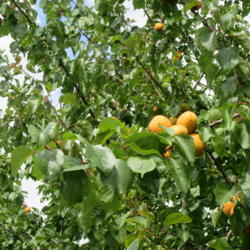
Apricots are beautiful to look at and wonderful to eat, but many people still don't fully appreciate them. Fresh apricots are difficult to find in many markets because they don't ship well. Apricot trees can be a lovely centerpiece in a yard: their blossoms are white or pink; their foliage is bronze in the spring, deep green in the summer, and yellow in the fall.
The commercial growing range for apricots is limited, but home gardeners can grow them successfully in many parts of the country by selecting the right variety and location for the tree. Genetic dwarf varieties can be grown in containers. In areas with severe winters, you can wheel them into the garage or other sheltered area until spring warms things up outdoors.
Planning for SuccessApricots bloom earlier in the spring than other fruit trees and have only a limited tolerance of high summer heat. While the tree is fairly hardy (some varieties withstand winter lows down to -20° F), it can bloom too early--if you get a warm spell in late February or early March. In areas that have late frosts, you can choose some of the newer varieties developed in the North that bloom later and produce well in harsh climates.
VarietiesWhen choosing a variety, select one recommended for your zone and climate that will flower after the last spring frost in your area and that will live through your winter. In preferred apricot growing areas such as Santa Clara and San Benito counties in California, you will want to consider the ripening period--early, midseason, or late. Most varieties are self-fertile; that is, one variety is all you need for trees to fruit. The full-size trees generally grow be between 20 and 30 feet tall and live about 75 years. Most will start bearing in their third or fourth year. Expect 3 to 4 bushels of fruit from a standard-size tree, 1 to 2 from a dwarf variety.
Reliable dwarf apricot trees are rare, if you really want a dwarf tree, try a genetic dwarf such as 'Stark Golden Glo' or 'Garden Annie' apricot. These trees are naturally small, so they don't need to be grafted onto dwarfing stock. Buy dormant, bare-root, 1-year-old trees, if possible. Plant trees in early spring in the North and East; in California and other mild-winter areas, you can plant in the fall.
Photography by USDA
 Victory Seed Company has all the seeds you want for your best garden in 2024.
Victory Seed Company has all the seeds you want for your best garden in 2024.
For 25 years, the family-owned Victory Seed Company has provided the highest quality vegetable, herb and flower seeds to families across the country. We are passionate about providing you the best seeds available that give excellent germination, robust plants, and the harvest you want. With a catalog of over a thousand varieties, we have everything, and our prices are the kinds that we'd want to pay. We have hundreds of yesterday's heirloom vegetables, as well as today's award winning hybrid selections. Get to know us by visiting our website and browsing through our online vegetable seed catalog.
| 1. Apricot Essentials |
| 2. Planting Apricots |
| 3. Growing Apricots ← you're on this article right now |
| 4. Care for Apricots |
| 5. Growing Apricots in the North |
| 1. Apricot Essentials |
| 2. Planting Apricots |
| 3. Growing Apricots ← you're on this article right now |
| 4. Care for Apricots |
| 5. Growing Apricots in the North |